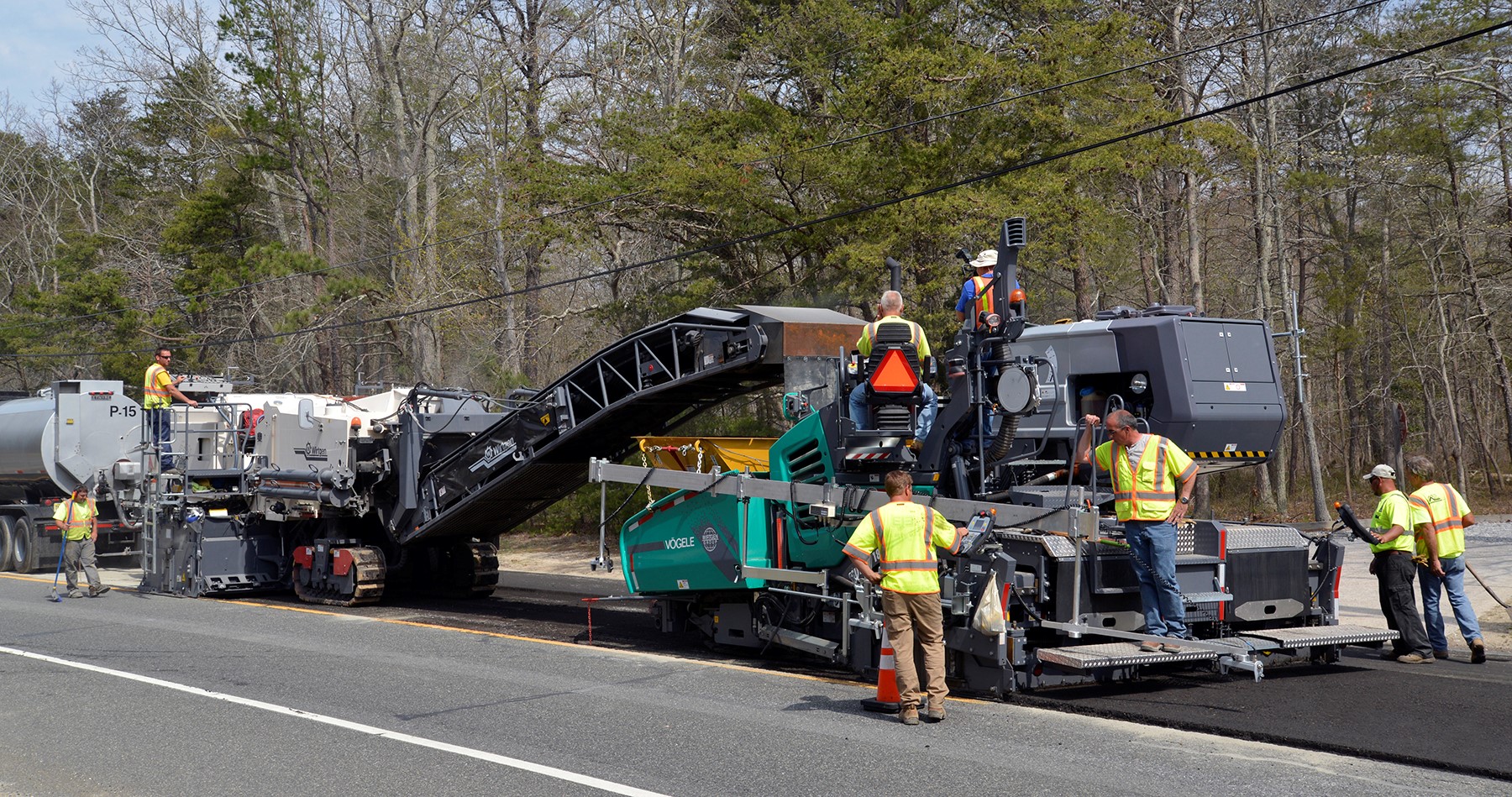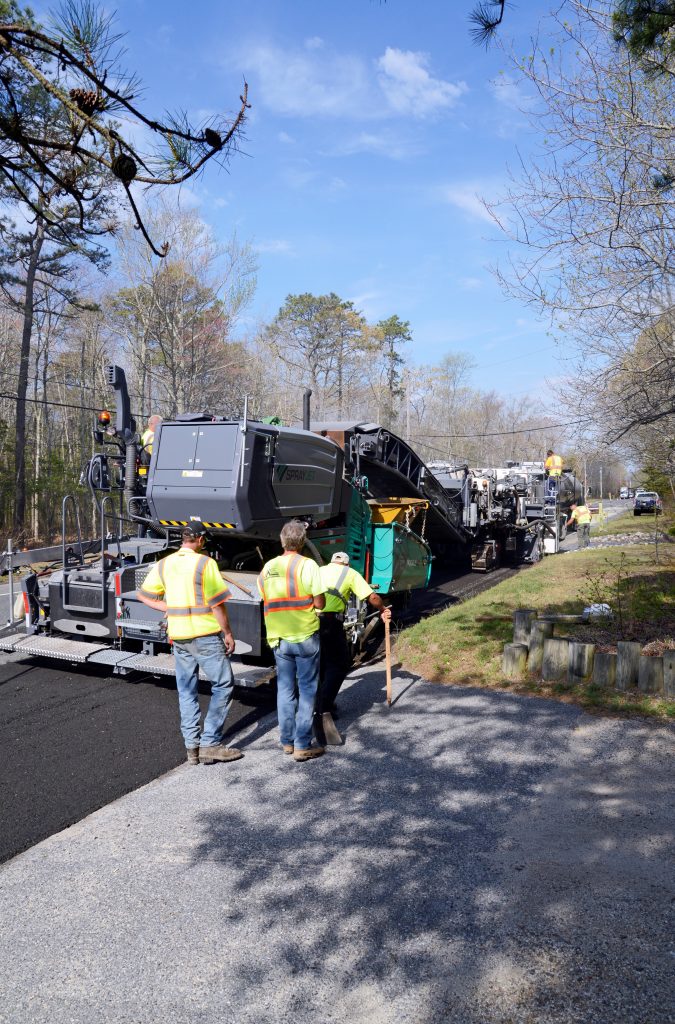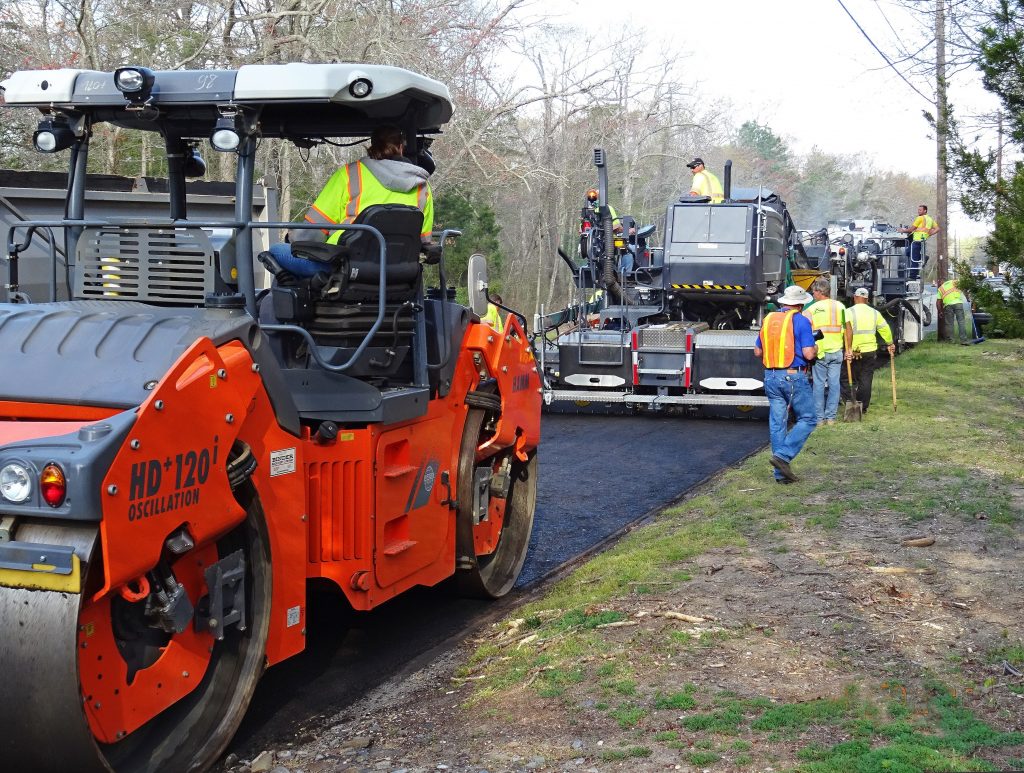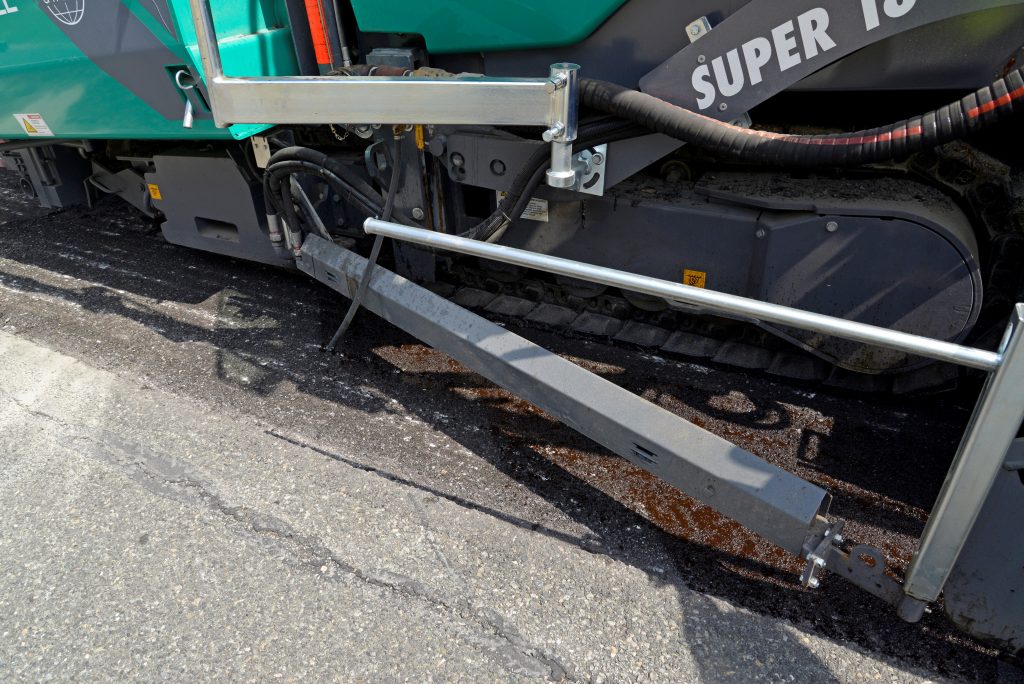Asphalt Pavement Systems Inc. Manages Multiple Paving Techniques in a Day
BY Tom Kuennen

In-place recycled foamed asphalt—placed with a SprayJet paver in one pass and topped with micro surfacing—provided same-day rebuilds for a rural pavement in south New Jersey. In this project, aged bituminous lifts of New Jersey S.R. 83 in Cape May County were asphalt foam-recycled just over 3 inches—down to the existing concrete slabs—using a full lane in-place recycler, which revealed the surface of the slabs.
In one continuous pass, the Wirtgen 3800 CR recycler placed the foamed recycle mix into the hopper of a following Vögele Super 1800-3i SprayJet paver, which shot an asphalt emulsion bond coat onto the slabs immediately ahead of the recycle mix placement. To preclude damage to the existing concrete slabs this mix was compacted using oscillation compaction from a Hamm HD+ 120i VO roller in breakdown position.
Finally a micro surfacing driving course was placed on the 100 percent recycled pavement, followed by lane striping. An entire paving sequence from recycle to striping was taking place in one day, with multiple days involved for the complete project.
Asphalt Pavement Systems Inc. of Hammonton, New Jersey, was the general contractor for the project, undertaking cement spreading, the recycling, the compaction and the finished micro surfacing.
Fight Block Cracking

The team used oscillation compaction instead of vibration to provide minimal disturbance to the concrete slabs under the foam-recycled pavement.
“We’re in-situ recycling 3 inches of existing pavement, and paving back 3 inches of recycled pavement,” said Mike Marshall, director, recycling products, for Wirtgen America Inc. “It’s the first project in New Jersey using the cold-in-place foamed asphalt process, and the first to use a spray finisher concept.
“Because we are exposing the concrete by recycling all the asphalt, we are simultaneously applying emulsion tack coat to the concrete using the spray finisher, and then laying the recycled material immediately on top of the bond coat,” Marshall continued. “This forms a complete bond between the concrete and recycled layer. It’s never been done before; it’s an entirely new concept.”
Foamed asphalt mixes incorporate liquid “foamed” bitumen or asphalt as a stabilizing agent, in which hot liquid asphalt is foamed with water and air, and injected into reclaimed materials or aggregate in a mixing chamber. Precise addition of water allows control of the rate and amount of asphalt foam expansion. The expanded asphalt has a resulting high surface area available for bonding throughout the materials, leading to a stable cold mix that can be overlaid with a thin wearing course.
“With foamed asphalt, it’s not a coating process; instead the foam bubbles burst and attach to the fines,” Marshall said. “This creates a mortar effect, which locks in the larger particles, but doesn’t continuously bind them. Therefore you can have some movement in the bottom of the layer that is not transmitted all the way to the top of the layer. That feature permits greater resistance to reflective cracking from the underside.”
Micro Surface the Top

The team used oscillation compaction instead of vibration to provide minimal disturbance to the concrete slabs under the foam-recycled pavement.
Following oscillation compaction with a tandem roller, the pavement was micro surfaced. According to FP2 Inc., micro surfacing is a high-performance enhanced slurry seal composed of a mixture of polymer-modified emulsified asphalt, dense-graded crushed fine aggregate, mineral filler, break control additives and water. The emulsifiers and additives allow micro surfacing to be placed at thicknesses up to 1.5 inches and the surface to cure in less than an hour.
“The New Jersey DOT is looking for a highly economic solution to their problems, and the combination of the recycle layer and the micro surfacing should save a significant amount of dollars,” Marshall said. “The existing strength of the pavement will be enhanced, as well as the rideability.”
Segments of the pavement were completely recycled, micro surfaced, striped and opened to traffic each day over a 10-day period. “The way the construction is organized, we will recycle, compact, seal and stripe the pavement, and open it to traffic that evening,” Marshall said. “The only closure will be during the day in the work zone. Every night road users will enjoy a rebuilt road segment that’s striped and ready to go.”
The project on New Jersey S.R. 83 was approximately six linear miles by 40 feet wide. Ahead of the recycler, cement was distributed by a precision Streumaster spreader to an amount equal to 1 percent by mass of the recycled material, 4.6 pounds per square yard.
Then a Wirtgen 3800 CR recycler worked from the outside-shoulder-in, 12-foot 6-inch width, adding 2.4 percent foamed asphalt in addition to the 1 percent cement. For a second pass, the 3800 CR picked up from the centerline, and worked 10 feet wide with foamed asphalt, which provided a full-lane width homogeneous blend from centerline to the outside of the shoulder. Optimally the recycler would operate at about 29 feet per minute, approximately 360 tons per hour.
When the recycle train reached the end of the project, it turned around and recycled the opposite lane in one pass.
An asphalt emulsion tack or bond coat was being placed on concrete slab passes only, not the shoulders, said Wirtgen’s Mark Stahl, recycling products manager. “In the shoulders, once you remove the asphalt, all you have is aggregate and dirt below,” Stahl said. “We’ve seen there’s no sense in placing a tack coat on top of dirt/aggregate. We won’t apply it there but do place it on the main line.”
Minimize RAP Piles

The SprayJet paver places polymer-modified bond coat immediately in advance of the foam-recycled mix.
“The significance of this project to New Jersey is twofold,” said Robert Capoferri, owner of Asphalt Paving Systems Inc. “We’re introducing a recycling process that can help minimize the amount of RAP being stored at asphalt plants around the state. This process utilizes the existing asphalt and recycles it in-place, making a totally green product.”
Test results for this pilot project were coming out exceptionally well, Capoferri said. “Compaction on the foamed lift is in the neighborhood of 98 percent, with 83 percent coming off the back of the paver. The benefit of the oscillation compaction is that we will not damage the concrete beneath the pavement. We don’t want to disturb the slabs any more than need be.” Target density was 95 percent (5 percent air voids).
Micro surfacing must be delayed several hours before placement on the foamed asphalt lift, he said. “We’re letting the moisture evaporate out of the mix, allowing it to stiffen or tighten up,” Capoferri said. “The micro surfacing is done to weatherproof the surface.”
When cold milling is called for, Capoferri converts the 3800 CR recycler into a milling machine.
Capoferri uses his Vögele Super 1800-3i SprayJet paver to do more than place recycled subbases. “We have two of them, and we use them for thin bonded overlays,” he said. “For this operation it permits us to tack-coat the concrete as we’re going, eliminating any sliding of the base that might occur. We’re using a heavily polymer modified emulsion that will help the subbase bond with the concrete.”
For the subbase, the Hamm roller was used in the breakdown position in oscillation mode. It was followed by a vibratory tandem roller in intermediate position, and a pneumatic roller for finish. The rubber-tired roller also was used to compact the micro surfacing.
“In-place recycling has many benefits to local governments,” said Gregory D. Bitsko, P.E., senior director of structural engineering for Cherry, Weber & Associates, of Freehold, New Jersey, who was observing the process and who previously had designed a foamed asphalt reclamation project for the Delaware River Joint Toll Bridge Commission. He spoke specifically of a cost advantage. “It allows very scarce funds to go farther,” he said. “Savings from projects where recycling is possible frees up resources for projects where those opportunities don’t exist.”
